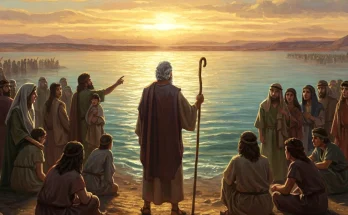What if the beast and false prophet aren’t just strange symbols—but real forces still shaping our world today?
Revelation speaks of terrifying figures: one rising from the sea with power and blasphemy, the other performing miracles to deceive the nations. These two—known as the beast and false prophet—have stirred fear, debate, and fascination for centuries.
Even now, we hear questions. Are they literal end-time rulers? Do they represent empires or systems already past? Could both be true in different ways?
Understanding the beast and false prophet isn’t just for prophecy experts. It matters for every believer seeking wisdom, courage, and faithfulness in a confusing world. Scripture gives us more than just clues—it offers a lens to see clearly and stand firm.
Parables: The Mysteries of God’s Kingdom Revealed Through the Stories Jesus Told by John MacArthur
In this study, we’ll explore what Revelation actually says. Then we’ll compare two major views: Dispensational and Partial Preterist. One sees these figures in the future. The other sees them in the past.
Either way, the truth shines brightest when we look to God’s Word together. Let’s dive in.
The Beast in Revelation: Biblical Overview
Apostle John tells us, “And I saw a beast rising out of the sea…” (Revelation 13:1). From the very first moment, we sense something dreadful is unfolding. This beast has ten horns and seven heads, with blasphemous names written on its heads. It looks like a leopard, but its feet are like a bear’s and its mouth like a lion’s. The dragon—Satan—gives the beast its power, throne, and great authority.
As we read further, the world responds with awe. People worship the dragon because of the beast, saying, “Who is like the beast, and who can fight against it?” (Revelation 13:4). It speaks with arrogance, boldly blaspheming God. It wages war against the saints and is allowed to conquer them for a time. Yet its power is limited—just forty-two months. During this period, only those whose names are not written in the Lamb’s Book of Life will worship it.
This first beast is a terrifying symbol of evil that stands against God and His people. It points to systems or powers that demand worship, oppose truth, and persecute the faithful. However, the vision doesn’t end there. Revelation 13 introduces another figure—a second beast. This one rises from the earth and works signs and wonders. It leads the world to worship the first beast and enforces the infamous mark. This second figure is later called the false prophet, forming an unholy alliance: the beast and false prophet. We’ll explore his role in more detail in the next section.
Though the imagery is intense, we’re not left in confusion. The beast is dangerous, yes—but not victorious. The Lamb still reigns. And we, the faithful, are called to endure with hope and confidence in God’s ultimate justice.
The False Prophet: A Second Beast
Right after the first beast appears in Revelation 13, a second one rises—this time from the earth. This figure has two horns like a lamb but speaks like a dragon. That detail alone tells us something is off. While he appears gentle, his words reveal a deeper deception. This second beast is later identified as the false prophet, and his mission is clear: to support and promote the first beast.
He performs great signs, even calling down fire from heaven in full view of others. Because of these signs, he deceives those who dwell on the earth. Through his influence, people are led to worship the first beast, the one who seemed to recover from a mortal wound. He even creates an image of the beast and gives it breath, so it can speak and act.
It doesn’t stop there. The false prophet enforces a terrifying rule—no one can buy or sell unless they have the mark of the beast. This mark is either on the right hand or the forehead. It’s a clear sign of allegiance, and refusing it comes with great cost.
Together, the beast and false prophet form a powerful and deceptive partnership. They operate under the authority of the dragon—Satan—who was introduced in Revelation 12. This unholy trio mirrors the holy Trinity but in a twisted, rebellious way. Their goal is to lead the world away from truth and into false worship.
Though the signs are impressive and the pressure to conform is strong, Scripture reminds us that their end is certain. Revelation 19:20 tells us that both the beast and false prophet are thrown alive into the lake of fire. God’s justice will prevail. Until then, we’re called to stand firm in truth, no matter the cost.
The Fate of the Beast and False Prophet
The story of the beast and false prophet ends with their total defeat. In Revelation 19:20, we see what happens when Jesus returns in glory. The beast and false prophet are captured and thrown alive into the lake of fire that burns with sulfur. There’s no struggle. No second chance. Their power ends instantly in the presence of Christ.
Then, in Revelation 20:10, we’re told their judgment is eternal. The devil joins them in the lake of fire, where they will be tormented day and night forever. This is not symbolic of temporary punishment—it’s final and unending.
Although the beast and false prophet seem unstoppable for a time, their fate reminds us that evil doesn’t win. Jesus is not just the Lamb who was slain—He is also the King who conquers. No matter how dark the world becomes, His justice will prevail.
This truth gives us hope. We may face deception, pressure, and persecution, but the end is already written. The beast and false prophet lose. Christ reigns forever. And those who remain faithful will share in His victory. Let’s hold fast to that promise as we follow Him with courage.
Dispensational View: Future Global Figures
Dispensationalism is a way of understanding the Bible that sees God working in different eras or “dispensations.” One key belief is that many end-time prophecies — especially in Revelation — are yet to be fulfilled. This view takes a more literal approach to prophetic Scripture and expects future events to unfold on a global scale.
The Beast as a Future Antichrist
In this interpretation, the beast in Revelation represents a future world leader. Many identify him as the Antichrist—a powerful political and military figure who rises during a time of great turmoil. He will unite nations, perform wonders, and demand worship. According to this view, his rule begins peacefully but becomes violently opposed to God and His people.
The False Prophet as a Religious Deceiver
The second beast, known as the false prophet, is seen as a future religious leader. He promotes worship of the Antichrist and performs miracles to deceive the masses. His goal is to draw people into a global false religion, rejecting the true God in favor of lies and idolatry. Together, the beast and false prophet form a dark alliance of political and spiritual control.
The Seven-Year Tribulation
This view places the beast and false prophet at the center of a literal seven-year tribulation period. The tribulation begins after the rapture—when believers are taken to be with Christ. The Antichrist then confirms a peace treaty, especially concerning Israel, and gains global influence. Midway through the seven years, he breaks the treaty, desecrates the temple, and unleashes fierce persecution.
Global Control and the Mark
The false prophet enforces the infamous “mark of the beast,” without which no one can buy or sell. Believers who refuse the mark will face suffering and even death. This persecution, however, reveals the true loyalty of God’s people.
Popular Influence
The dispensational view became well-known through the Left Behind series by Tim LaHaye and Jerry Jenkins. These books imagine what life might look like during the tribulation and reflect many ideas from this interpretation.
In the dispensational view, the beast and false prophet are not distant symbols—they are future rulers who will openly oppose God. Yet even in this view, Christ returns in glory to defeat them and restore His kingdom.
Partial Preterist View: Past Fulfillment in Roman Empire
The partial preterist view sees much of Revelation as fulfilled in the first century. “Preterist” comes from a Latin word meaning “past.” Unlike futurist views, this perspective places many prophecies—including the rise of the beast and false prophet—within the historical context of the early Church.
The Beast as Rome or Nero
In this interpretation, the beast in Revelation represents the Roman Empire, which held enormous power and demanded loyalty. Some even connect the beast to Emperor Nero himself. Nero’s cruelty, persecution of Christians, and claimed divinity fit many of the beast’s traits. His name may even be hidden in the number 666, depending on how it’s calculated in ancient languages.
The False Prophet as Religious Corruption
The false prophet is often seen as a symbol of corrupt religion. Some believe this points to apostate Jewish leaders who rejected Jesus and aligned with Roman power. Others suggest it refers to Roman priests or cult enforcers who promoted emperor worship. Either way, the beast and false prophet work together to lead people away from God.
Persecution of Early Christians
First-century believers faced enormous pressure. They lived under a regime that demanded allegiance to Caesar and punished those who confessed Christ. The book of Revelation was written to encourage them—to show that Jesus reigns, even when Rome seems unstoppable. The beast and false prophet symbolize the spiritual and political powers that tried to crush the early Church.
The Fall of Jerusalem in AD 70
A key moment in this view is the destruction of Jerusalem and the temple in AD 70. This event fulfilled many of Jesus’ prophecies (see Matthew 24). It also marked the end of the old covenant era. Many believe Revelation’s imagery points to this judgment against Jerusalem and the apostate religious system.
In the partial preterist view, the beast and false prophet aren’t future figures—they’ve already come and fallen. Their judgment is history. Yet Revelation still speaks to us today. It reminds us that Christ has conquered, and our faith must remain strong in every generation.
Key Differences Between the Two Views
When we compare the two views, we find key differences in how they interpret the beast and false prophet. Dispensationalists see them as future global figures—one a political antichrist, the other a false religious leader. Partial preterists, on the other hand, see these figures as already fulfilled in the past, tied to the Roman Empire and corrupt first-century religion.
One view takes the imagery more literally. The other leans symbolic, focusing on historical context. This leads to different understandings of the “last days.” In the dispensational view, we’re still waiting for these events. In the partial preterist view, many of them have already happened—especially with the fall of Jerusalem in AD 70.
Both perspectives agree on this: the beast and false prophet oppose God, deceive many, and ultimately face judgment. However, how we view these prophecies shapes our sense of urgency, hope, and preparation. Are we watching for a coming storm—or recognizing one already passed?
No matter the view, Revelation calls us to stay faithful. We’re reminded that evil never gets the final word. Jesus does. That truth unites us, even when interpretations differ.
Halley’s Bible Handbook, Classic Edition
The bestselling Bible handbook of all time with millions of copies sold, the Halley’s Bible Handbook makes the Bible’s wisdom and message accessible to everyone.
What We Can Learn Either Way
Whether we see the beast and false prophet as past or future, Revelation gives us clear truths to hold onto. Evil will be judged. That’s certain. These figures may rise for a time, but their end is already written. God’s justice never fails.
Deception, though, is real and ongoing. We may not face fire from heaven or a literal mark, but false teaching and pressure to compromise still surround us. That’s why we must stay alert. The enemy doesn’t always appear with horns—sometimes he comes with charm and half-truths.
Revelation 14:12 offers a powerful reminder: “Here is a call for the endurance of the saints, those who keep the commandments of God and their faith in Jesus.” That’s our call too. No matter how we interpret prophecy, we know the path forward—faithfulness, endurance, and discernment.
So, even if we differ on timelines, we stand together in purpose. The beast and false prophet may stir fear, but they also stir resolve. We belong to the Lamb. Let’s walk in truth, stay grounded in Scripture, and encourage one another to endure to the end. Victory is not a question. It’s a promise.
Final Thoughts Beast and False Prophet
As we reflect on the beast and false prophet, we don’t need to be afraid. But we do need to stay alert. Scripture reminds us that deception is subtle, and spiritual battles are real. That’s why staying grounded in God’s Word matters more than ever.
These symbols—though mysterious—still speak to us today. They challenge us to ask: What voices are shaping our beliefs? Where are we placing our trust? The answers help us stay faithful in a world full of confusion.
We invite you to keep studying, keep asking questions, and keep growing in discernment. There’s more to explore in Revelation—more encouragement, more warning, and more hope.
If you’re ready to dive deeper, check out our other studies on eschatology. Together, let’s pursue wisdom, walk in truth, and trust that the Lamb will lead us safely home. Victory over the beast and false prophet is already assured.
Frequently Asked Questions (FAQ) The Beast and False Prophet
1. Who are the beast and false prophet in the book of Revelation? The beast is often seen as a powerful ruler or empire that opposes God. The false prophet supports the beast through deception and false worship. Together, they represent spiritual and political rebellion against God.
2. Are the beast and false prophet real people or symbolic figures? That depends on your view. Dispensationalists see them as future global leaders. Partial preterists interpret them as past symbolic figures tied to Rome and apostate religion.
3. What is the role of the false prophet? The false prophet performs deceptive miracles, promotes worship of the beast, and enforces the mark of the beast. His role is spiritual deception.
4. What does the mark of the beast mean? Some see it as a future literal mark. Others view it symbolically—representing allegiance to worldly powers instead of God.
5. Why is it important to study the beast and false prophet today? Because their message warns us to stay faithful, discern truth from error, and trust Christ, no matter the cost or culture.




